Wattle
BackWattles are a part of the legume family known as Fabaceae and are one of Australia’s best known native plants. In fact, the golden wattle (Acacia pycnantha) is Australia’s national floral emblem.
There are approximately 1,000 different native wattles with most producing fluffy pompom or cylindrical flower spikes in shades of gold, brilliant yellow or cream. However there are exceptions like the unusual red flowering Acacia leprosa “Scarlet Blaze” or the lovely Acacia purpureapetala with its purple tinged flowers. Many wattles flower in winter and early spring and their spectacular blossoms are guaranteed to attract a wonderful entourage of birds and bees. Birds will also be attracted to the seeds produced later on, some of which are edible for us too.
Wattles are available in all shapes and sizes from low growing shrubs to medium sized trees and even as grafted weeping standards. They are fast growing and make excellent ‘pioneer or nurse plants’ in new gardens providing shelter and shade for slower growing plants. Unfortunately they come with a limited life span (7–15 years) after which they will go into rapid decline.
How To Grow Wattles
With so many different types it’s a little difficult to generalise but here goes…
Wattles should be planted in full sun or part shade locations. They grow well in most soil types provided they have good drainage. If you’ve got heavy clay soil then raise the garden bed and apply gypsum to improve the drainage.
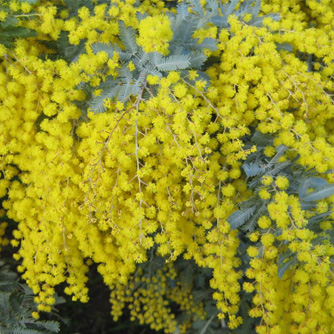
Cootamundra wattle (Acacia baileyana)
In milder climates wattles can be planted at any time of the year. Regions with hot dry summers should wait until autumn or winter to give them time to settle in before the heat of summer. The prostrate wattles and small growing types (like Acacia cognata) can also be grown in pots but always use a special native potting mix. Water all plants well with OCP eco-seaweed to reduce the transplant shock and give them a great start.
Wattles can be fussy regarding rainfall and humidity. If they originate from a region with hot dry summers then they may struggle if you live somewhere which experiences humid wet summers. They may die quickly or just fail to thrive and develop a lot of dieback in older leaves. Conversely some may go into overdrive with all that extra moisture and end up being very short lived or turn weedy. Confused? Speak to your local nursery or council to find out which varieties are suited to your area and if any have been listed as weeds for your region.
Fertilising and Maintenance of Wattles
Wattles, like some other natives, are sensitive to too much phosphorous and typically have low nutrient requirements. Established plants can be fertilised in spring and autumn with a layer of compost or a certified organic native fertiliser. New plants, or those which you wish to push along, can be fed with a mixture of OCP eco-seaweed and OCP eco-aminogro every 2-4 weeks.
If you have an older plant which is showing signs of decline (branch dieback and borers) and you want to try to extend it’s life then apply OCP eco-seaweed and OCP eco-aminogro every 1-2 weeks around the soil. This can often revitalise the plant but bear in mind they are short lived plants and ultimately it will go back into decline.
Wattles do not usually require pruning however some people believe it promotes vigour and extends their life. They give a light prune after flowering finishes.
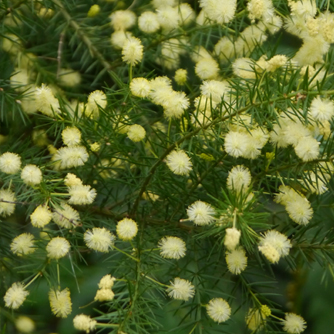
Prickly moses wattle (Acacia verticillata)
Pests and Diseases of Wattles
If you’ve chosen the right wattle for your climate then they are very easy to grow and have few problems. If something does go wrong it’s likely to be one of the following:
-
Scale - there are several different types with most attacking branches and stems. Some are very easy to spot while others blend in well. The presence of sooty mould or lots of ants on branches (when not in flower) is a sure sign that scale are feasting. Spray with a horticultural oil a couple of times to control them.
-
Borers – the larval grub of beetles (or sometimes moths) that tunnel into the trunk and main branches resulting in branch dieback and even plant death. Look for oozing sap and sawdust material (frass) as clear indications of borer attack. Being able to kill the grub is virtually impossible as insecticides can’t reach them but sometimes it is possible to prune out affected branches. It is important to realise that borers attack stressed or aging trees so even if your pruning is successful the borers will most likely return. Focus on removing any stress factors and stimulate tree health with weekly applications of OCP eco-seaweed and OCP eco-aminogro. If the tree is quite old then consider replacing it.
- Bag-shelter moths – these cluster caterpillars build a “bag” of leaves, twigs and webbing which they shelter in during the day and then feed on leaves at night. They’re hungry feeders and can strip a plant in no time. If practical remove the bags by hand but wear gloves as the caterpillars have long brown hairs that can cause painful rashes. If you can’t remove the bags then spray the tree with OCP eco-neem for effective caterpillar control.
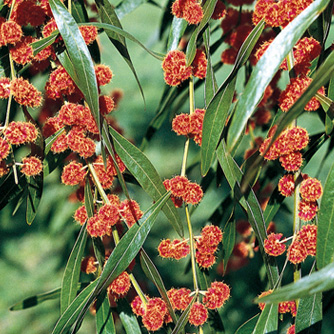
The unusual red flowering wattle Acacia 'Scarlet Blaze'
- Galls – these are irregular small bumps or growths which can occur on foliage or stems and are usually caused by various insects. In healthy growing wattles this is nothing to worry about and can be ignored or pruned off if they bother you. If you find your wattle has a lot of them then it’s generally a sign the plant is struggling and needs some TLC (see our recommendations above with borer attack). There is a fungal disease called gall rust which results in larger galls developing (up to 15cm across) and these should always be pruned out to minimise further spread.
- Spittle bugs – these are small sap-sucking insects that surround themselves with white froth (hence their name). Spraying is not needed as they do little damage but the “spittle” can look ugly so if it troubles you just hose them off.
Various other pests (like aphids, mites, mealybugs and more) can attack wattles from time to time. Protect young plants with OCP eco-oil or OCP eco-neem to control most problems but with established trees you rarely need to do anything especially if it’s a small outbreak and trees are otherwise healthy.
Some of Our Favourite Wattles
Acacia baileyana purpurea – this form of the Cootamundra wattle produces purplish new growth which then turns grey. Produces masses of bright yellow flowers mid to late winter and grows to 6 metres.
Acacia cognata – look for the dwarf growing cultivars like ‘Limelight’, ‘Mini Cog’ or ‘Fettuccini’ which have lovely rich green foliage and are compact growing. They are beautiful wattles even when not in flower and some cultivars are suitable for pots as well.
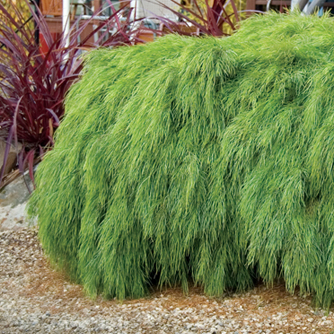
Lovely weeping foliage of Acacia cognata 'Limelight'
Acacia fimbriata ‘Crimson Blush’ – attractive rounded shrub with bronze new growth tips. Grows to 1.5m and looks excellent planted in groups.
Acacia floribunda –grows to 6m and makes a fabulous screen or hedge. Showy cream cylindrical spike flowers. Grows well in coastal areas but is also frost hardy.
Weed Watch - Remember that some wattles can become weedy when grown outside of their natural areas. Check with your local council or native nursery when selecting a wattle for your garden.
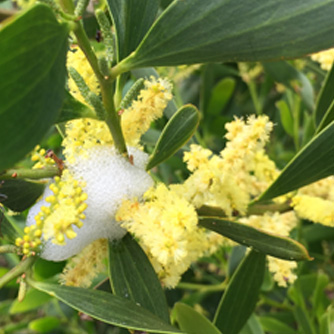
Spittle bug on wattle


